Buying Countertops: Plastic Laminates, Granite and Solid Surfaces
Updated: Nov. 22, 2022
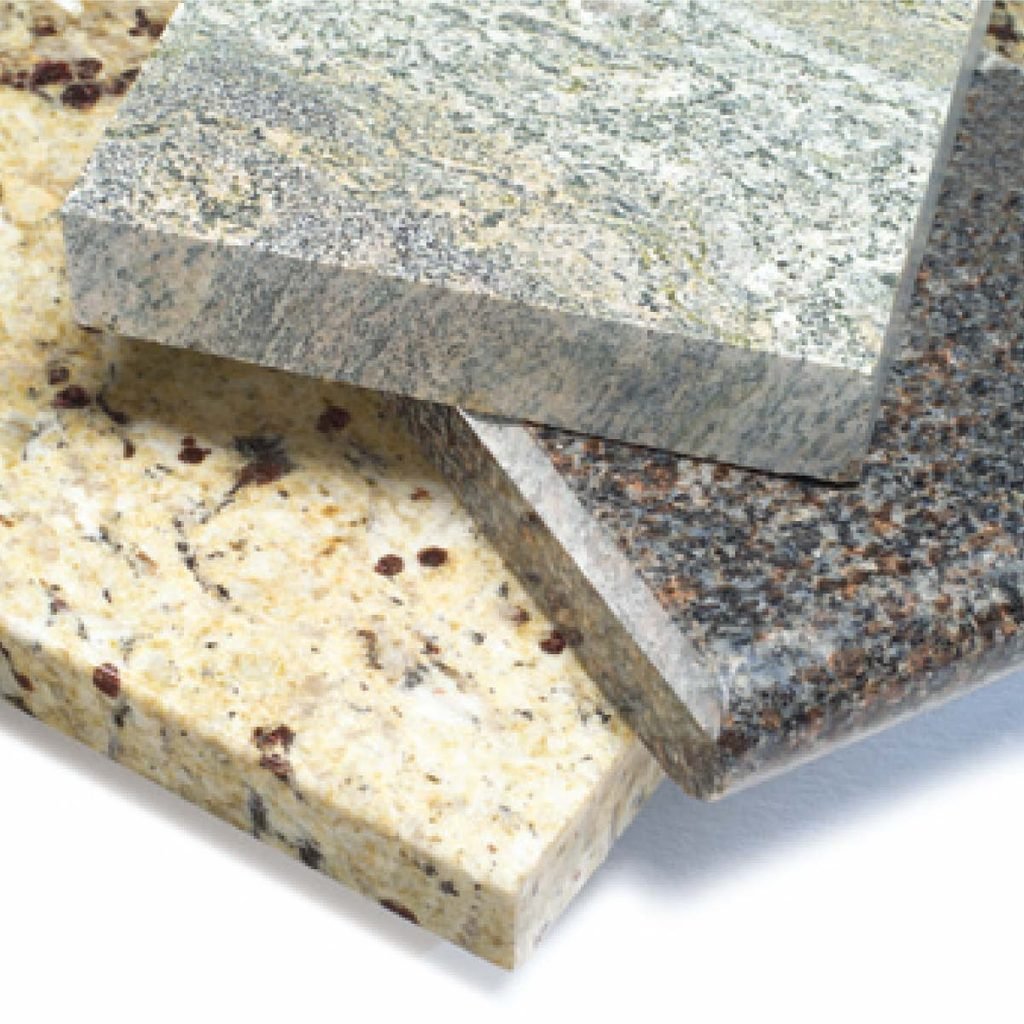
Pros, cons, costs (and some pretty strong opinions).
On This Page
Three Key Factors: Price, Maintenance and Appearance
When a sample of a kitchen countertop made from 60 percent paper recently crossed my desk, I realized tops could be, and are, made out of anything and everything. Wood, plastic, granite, metal, concrete, tile, acrylic—they’re all used. Seventy-five years ago, stone and wood were the primary countertop choices; 25 years ago, laminate was clearly king of the hill. But today’s kitchens and inexpensive countertops are used for more than just cooking. The kitchen is a living room, study, dining room, entertainment area, craft center and showplace all rolled into one. The many functions of this room today call for a countertop surface that suits our lifestyles and activities.
When people need a top that’s durable, simple to install, easy to maintain and affordable, most still head for the laminate display. But there’s a bewildering range of other choices out there today. They all have their strengths and weaknesses. They’re all pretty durable; no real stinkers in the bunch. They all require some maintenance or care. A wine glass dropped from two feet will shatter on any of them. So selecting inexpensive countertops really boils down to how you answer these three questions:
- How much can you spend?
- How much maintenance are you willing to do?
- What material do you most like to touch, see, show off and work on?
Check out 10 kitchen trends we’ve been seeing
Price: cheap countertops and expensive countertops
You can spend $2 to $250 per sq. ft. for countertops. Surprisingly, there are few choices that fall between the basic $10 per sq. ft. laminates and the $80 stone and solid-surface tops. Wood and tile tops fall in the middle, but of all the tops we looked at, these had the most critics. The scarcity of midpriced options can be a blessing in disguise; if you have a limited budget, look at the many design possibilities of laminate. Kitchen specialists follow a few rules of thumb based on experience:
The longer you plan to stay in a house, the more durable and upscale the countertop you should select. The “cost per year” becomes a bargain as the years pass.
Tops and installation usually compose ten to 15 percent of a kitchen remodel budget. Tops that fall outside this range may not look like they fit.
Put your money where your heart is—especially when you’re on a budget. If you love high-tech appliances or custom wood cabinetry, spend your money there.
Maintenance and use factors
Maintenance on most cheap countertops is minimal—but fail to do it and permanent, or at least difficult-to-reverse, damage can occur. There is preventive maintenance (mopping up spills, using hot pads, working on cutting boards) and long-term maintenance (which usually involves applying some form of sealer or finish). Ask yourself, how careful (really) are you and your family? What do you expect your top to look like in five years? Does it make more sense to stick with laminate until the kids are out of grade school?
Aesthetic and tactile factors
If budget and maintenance aren’t decisive factors in your mind, how the top looks and feels are the true deal makers. Both you and your countertop have a personality; select one that you can get along with. Texture, aesthetics, glossiness, “warmth,” how natural the material looks and feels, and how it fits in with the design of your kitchen and home are all part of the final equation.
One of the beauties of today’s trend toward multiple countertop surfaces is, when torn between two tops, you can install them both!
Wear and Maintenance
A chart comparing laminate, granite, solid surface, wood and tile countertops is available in Additional Information below.
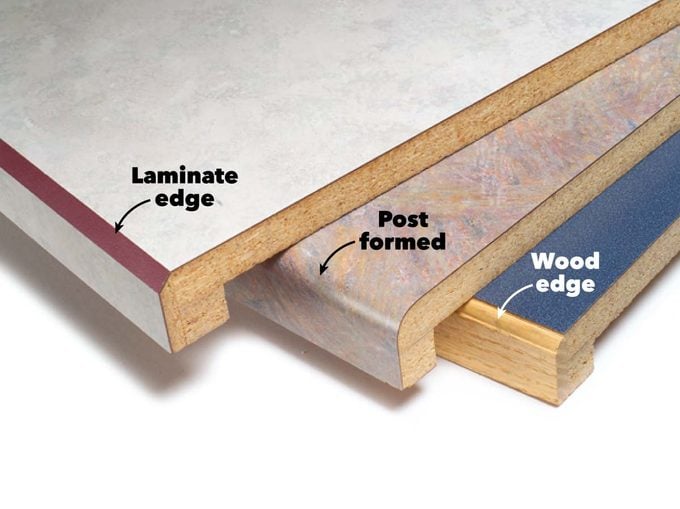
Plastic Laminates: Pros and Cons
Plastic-laminate tops may not grab many headlines, but they still account for 75 percent of the market. They’re inexpensive, durable, come in lots of colors and can be installed by do-it-yourselfers.
Plastic laminates are multiple layers of resin-soaked kraft paper, topped by a patterned sheet of melamine that’s subjected to heat and pressure. The resultant 1/16-in. laminate sheet can be made into cheap countertops in two ways.
It can be post formed at a fabrication plant to create tops with the rounded “unibody” backsplash and nosing. Post-formed tops can be purchased off-the-shelf at home centers in limited colors or special ordered. This style top is the least expensive, easiest to clean and quickest to install.
They can also be custom fabricated into an extraordinary range of styles. Laminate sheets are glued to particle board, then edged with laminate, wood, even solid-surface strips.
They resist grease and stains and clean with soap and water. They’ll take a good hit, and changing your color scheme won’t cost an arm and a leg.
On the downside, laminate tops can be damaged by hot pans and sharp knives, abrasive cleaners can dull the finish, and if water penetrates seams, the substrate can expand and the laminate bulge. Surface damage is difficult to repair. All of these problems can be avoided through proper installation and use.
Things to Know Before You Buy
- Darker solid colors and glossy finishes show scratches and cut marks more readily than patterned or matte surfaces.
- Tops where the laminate overlaps the edging, rather than butts to it are harder to damage.
- New technology in printing has improved the clarity and depth. Many wood grains and stone patterns are amazingly crisp and realistic.
Click here to learn more about selecting laminate countertops.
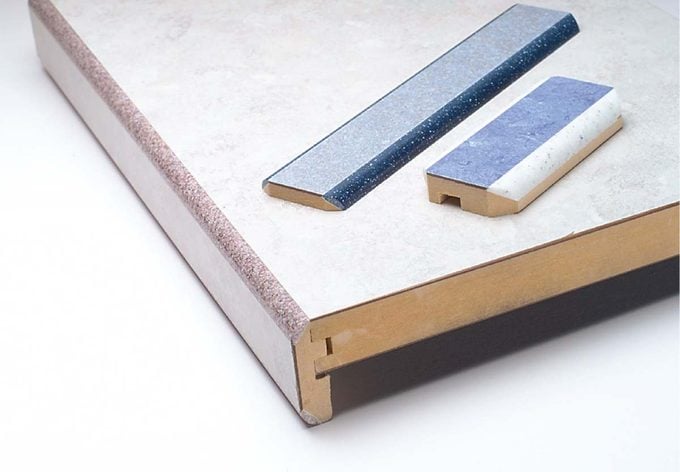
Counter Opinions
“Laminate worked with our budget. We chose great appliances instead of a costly top.” —homeowner
“There’s nothing wrong with laminate, but the high-end kitchen magazines are showing all stone. As the 1950s style swings back, laminate will be in vogue again.” —kitchen designer
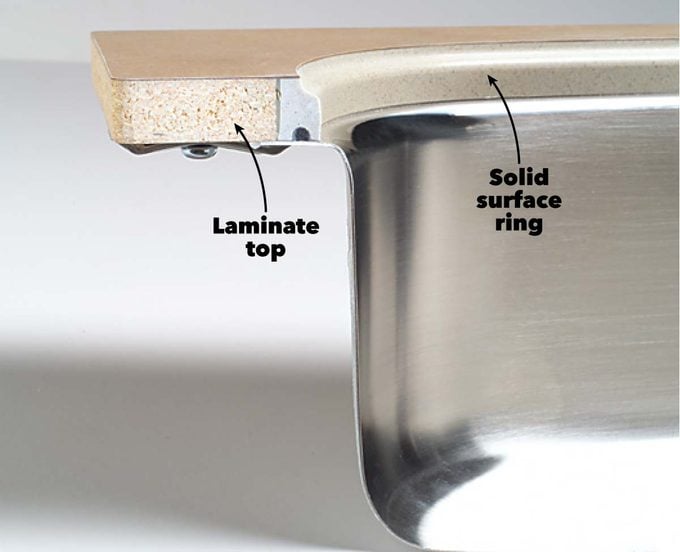
Jazzing Up Basic Laminate Tops
Three products on the market can help extend the versatility of laminate. Most are installed by your fabricator when your top is made.
Counter-Seal is a relatively new product that allows you to undermount a sink in a laminate top. Using templates and special tools, certified fabricators cut the sink opening, then line this opening with a closely engineered ring of solid-surface material. The tight fit of the ring and special adhesives protect the particleboard core from water and moisture. Prices start at about $250. The company also makes a product for do-it-yourselfers wishing to undermount a sink in a tile top.
Gem Loc is a solid-surface edging integrated into a laminate top during fabrication. It comes in a wide range of colors and styles.
Kuehn Bevel Edge is a specially milled laminate edging that eliminates the dark edge lines often found on laminates. Kuehn also makes other types of edgings.
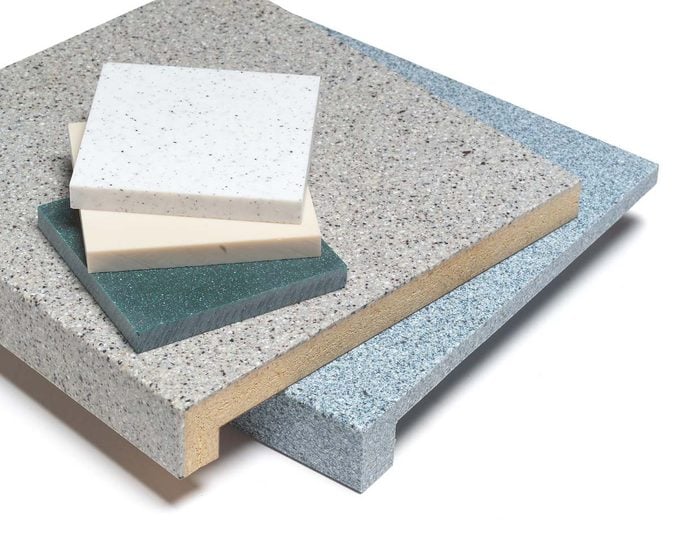
Solid Surface: Pros and Cons
DuPont introduced the first solid-surface countertop, Corian, to the world 35 years ago and the category continues to thrive. There are currently more than a dozen manufacturers offering countertop materials in hundreds of colors and designs.
Most, if not all, solid-surface tops are handled by trained pros who have been certified to fabricate and install that specific product.
Solid-surface tops are normally 1/2 in. thick and made of acrylic, polyester (or blends of the two) along with fillers. Edges are built up with two or three layers of material for a thicker appearance. One exception, Wilsonart’s Solid Surface Veneer (SSV), consists of a 1/8-in. layer of solid-surface material, bonded to a particle-board core. Some initial problems with the product were resolved by bonding a moisture-resistant layer to the bottom of the particle-board core.
Some have labeled solid-surface tops the “near-perfect” product. They’re non-porous, making them ideal for food preparation. They’re difficult to stain. They can be formed into nearly any size and shape. Because they’re of uniform material through and through, light scratches can be buffed out, deep scratches and burns can be sanded out, and severely damaged areas can literally be cut out, replaced, then blended to be darn near invisible. Sinks can be undermounted and backsplashes can be integrated into the top, making them seamless.
Most potential problems with solid-surface tops can be avoided by proper installation— and companies are increasingly selective in whom they’ll certify to do their fabricating. There are some negatives, however. It’s expensive. Cutting on them will leave scratches, and those that are solid color or have a high-gloss finish can be especially revealing. Some object to their homogenous look and cold feel.
Things to Know Before You Buy
- The key to a trouble-free solid-surface top is an installer who knows his or her stuff. Seams should be offset 1-1/2 to 3 in. from inside corners, inside corners should be radiused and joints should be reinforced.
- Know where your seams are and take precautions not to use crock pots, griddles and hot plates in that area. The expansion and contraction can cause cracks during the cool-down cycle.
- You can have a pro resand and repolish the top every five to seven years for a hard-to- tell-from-new look.
Counter Opinions
“Lots of people like solid-surface tops because they’re predictable; they’ll look the same five years from now as they do today.” —manufacturer
“Solid-surface tops were originally touted as being indestructible and having invisible seams; now they’re touted as being renewable with inconspicuous seams.” —installer
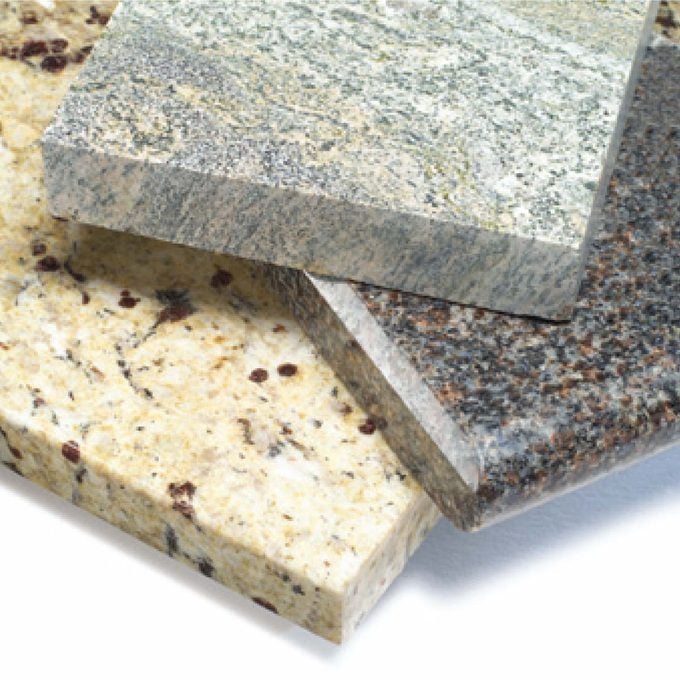
Granite: Pros and Cons
Although granite’s been around for millions of years, it’s still considered the new kid on the block. Ten years ago granite fell into the “exotic” or “extravagant” categories. Today it’s become more accessible and affordable. Shipping is easier (more than 90 percent comes from overseas), and new technology and thinner blades allow it to be cut with less waste and cost. In the 2001 National Kitchen and Bath Designs Trend Survey, 37 percent of the tops installed by its members were granite.
In its natural state it resists most stains and when sealed becomes tougher yet. Many edge styles can be crafted: most commonly bevel, radius, half-radius, ogee and square. A natural material, it comes in a wide range of colors, patterns and depths. Each top is absolutely unique. Sinks can be undermounted (in the case of one fabricator, 95 percent of the time.) And it can handle hot pans.
On the downside, neglected granite can be stained by hot grease. It’s hard and cold. It can be scratched by extreme abuse. Cutting on it will more likely dull your knives than damage your top, but repeated cutting in one area can eventually affect the sheen. Seams are more evident with granites that have a strong pattern or grain. And since working with granite requires special tools, it’s not a do-it-yourself material and on-site repairs are difficult to make.
Granite is an amazing option, but not always the correct one. Click here for 13 other options.
Things to Know Before You Buy
- Most slabs come in 9-x 5-ft. sections. The fabricator will often factor in a “waste charge” for the portion of the slab not used. Keep this in mind. For instance, don’t spec out a 10-ft.-long island, when a nine-ft. one will work.
- If possible, visit the granite “boneyard” and select the actual slab your top will be made from. The look of a large slab can differ greatly from a small sample.
- Dark and solid-colored granites show dings and spills more readily.
- Granite with a gloss finish will have more depth and liveliness than one with a matte finish, but it will also show scratches much more readily.
Counter Opinions
“Some people love a slab of granite because of a wild color or grain pattern. Others hate it for the same reason.” —fabricator
“Some customers feel tension that wasn’t there before granite. You do sort of tend to work around it.” —contractor
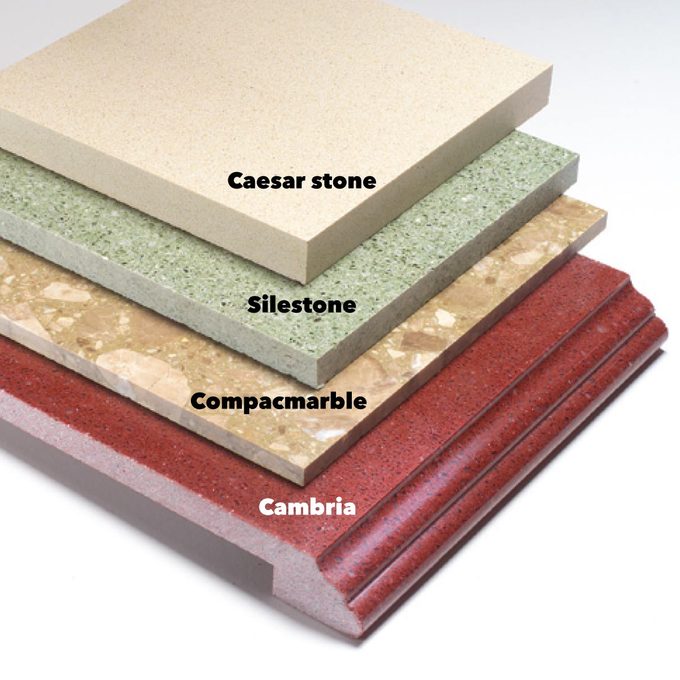
Engineered Stone: Pros and Cons
Blend the functional benefits of solid-surface material with the aesthetic attributes of natural stone and you get a new class of countertop materials called engineered stone. They’re composed of more than 93 percent crushed natural stone, bound together by acrylic or polyester resins. While new to the U.S. market, these tops have been used successfully in Europe for more than a decade.
Like solid-surface materials, they’re nonporous and nearly impossible to stain. Most never need sealing. They have excellent scratch resistance and have more “give” than granite. Because they’re composed of stone they can have a natural look. But because they also have resins and fillers they can also be tinted to create colors not found in nature.
They’re expensive, with most falling between solid-surface and natural-stone prices. And while manufacturers say they can stand up to hot pans better than solid surface materials, they can crack, even change color, if subjected to extreme temperatures. And they share some of granite’s negative qualities: They’re slippery, cold to the touch and unforgiving with a tipped glass.
Things to Know Before You Buy
- Manufacturers of the quartz-based products claim zero sealing is required—ever.
- The composites made of marble (CompacMarble) and limestone (Terrestone) are best suited for bathrooms.
- If you’re in a hurry, Cambria strives to manufacture and deliver your top in 14 days.
Counter Opinions
“If you’re looking for absolute zero maintenance on a kitchen countertop, this is as close as you’ll ever get. ” —manufacturer
“A small sample piece of the stuff might look like natural stone, but an entire countertop doesn’t. ” —designer
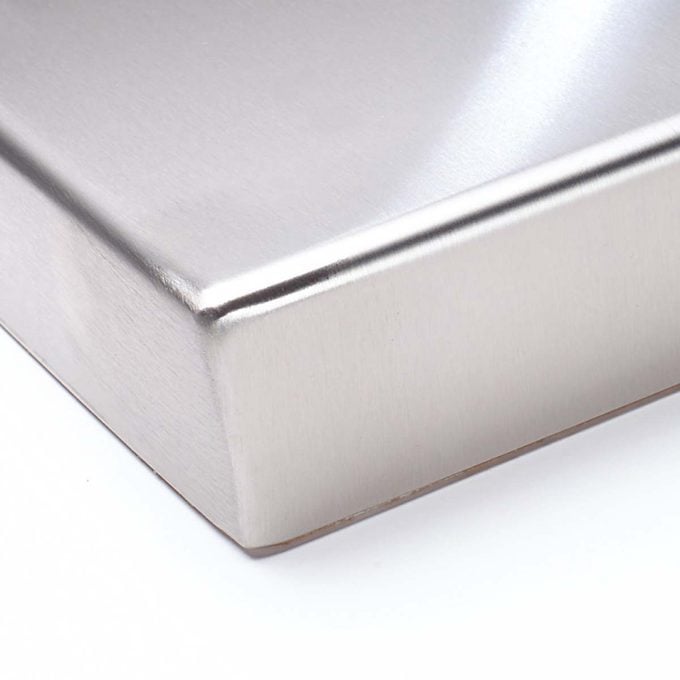
Stainless Steel: Pros and Cons
If all the great restaurants of the world use stainless-steel tops, why don’t you see more in homes? Well, they’re expensive and it’s difficult to find fabricators. Critics also point out that they show fingerprints and water spots easily (especially when new), and that they’ll readily show nicks, dents and scratches.
On the thumbs-up side, they’re completely anti-microbial, provide a good heat-proof surface and are easy to clean.
One manufacturer, John Boos, offers mail order stainless-steel tops in limited sizes.
Things to Know Before You Buy
- There are different grades and thicknesses of stainless steel. Make sure you know what you’re paying for.
- Make certain the stainless steel is wrapped completely around the edges of the substrate to protect it.
Counter Opinions
“It’s so sanitary, I sometimes feel like I’m preparing food on an operating table when I’m working on the stainless steel area of my top.” —homeowner
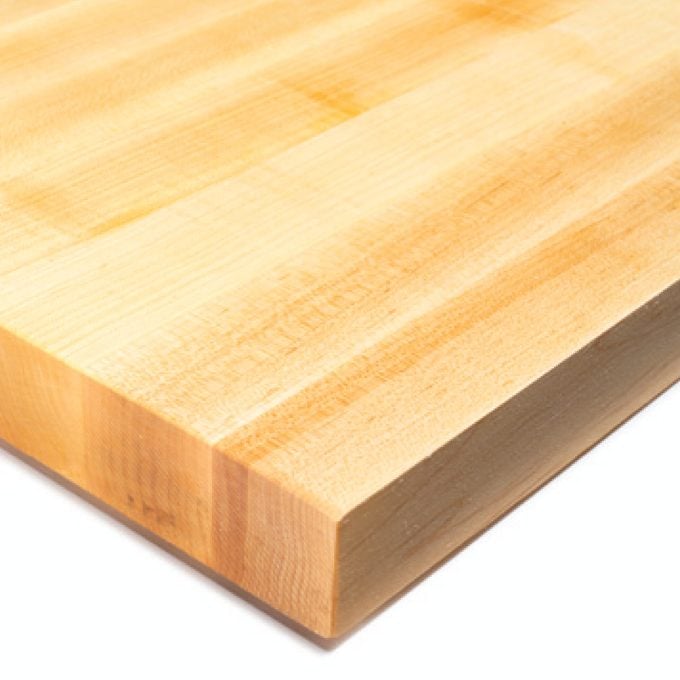
Wood: Pros and Cons
Wood is the original solid-surface countertop; it’s uniform through and through and damage can be repaired by sanding and recoating.
Most wood tops are created from 1-1/2-in. strips of maple edge-glued to one another. Oak and other woods are available, but constitute such a paltry share of the market that most need to be special ordered. End-grain maple tops—the true “butcher block” with the cut ends forming the cutting surface—are usually four or more inches thick and proportionately expensive.
For homeowners intending to use wood as their primary top, a penetrating oil finish is recommended because cuts and dings can be touched up with a little oil and a swipe of a rag. For those intending to use the surface as more of an eating area, tops with a varnish finish can be ordered.
Moisture is the number-one enemy of wood tops. Seams and areas around sinks are particularly vulnerable. And a wood top can, and will, expand and contract.
Counter Opinions
“Wood has a high fondle factor. People can’t walk by (our booth) without touching it.” —manufacturer at Kitchen and Bath Show
“It has too many weaknesses to be used everywhere in a kitchen. But a small chopping section is fantastic.&rdquo —designer
“Real wood with a (crack) is still prettier than (laminate) without one!” —manufacturer
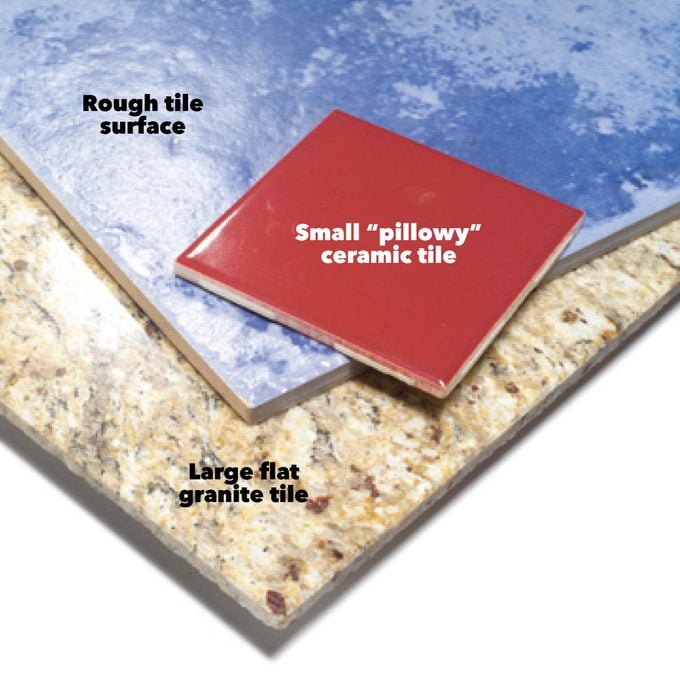
Tile: Pros and Cons
Tile has many virtues. It’s inexpensive, do-it-yourself friendly, available in an astounding variety of materials and colors, and it offers design flexibility. But it has equally strong drawbacks: It’s exceptionally hard, its piecemeal nature means some surface unevenness and the grout lines are vulnerable to staining.
Not all tiles are created equal. Granite, porcelain and glazed tiles are the least porous and are quite durable. Marble, unglazed clay or limestone tiles are absorbent, soft and usually not recommended for kitchens.
Grout is another part of the equation. Epoxy grout is more durable but harder to install and may yellow. Standard cement grout must be sealed often and well.
The tile base or substrate the tile is laid over must be solid and watertight. Backerboard over plywood is the most do-it-yourself friendly base. Many pros will form and build a “mortar bed” for laying their tile.
Things to Know Before You Buy
- High-gloss and solid-color tiles do show scratches.
- Select flat tile vs. that with a slight pillow effect to it.
- Using larger tiles leaves less room in between for grout, which will have to be sealed and maintained.
Counter Opinions
“It’s the ultimate do-it-yourself top, but I never thought about how difficult it would be to write on it or set down a wine glass.” —homeowner
“Well, let me put it this way: I’ve never had a client with an existing tile top ask me to design a new kitchen with a tile top.” —designer
Exotic Surfaces: Pros and Cons
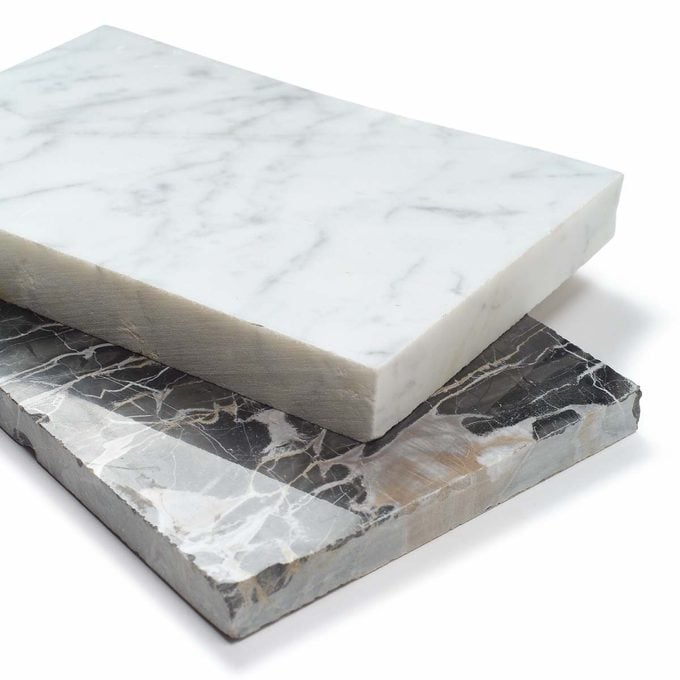
Marble
Marble can be, and is, used for kitchen countertops. But its porosity and fragility make it best suited for bathrooms, where it’s less likely to be damaged by knives, acidic foods and impact. But marble is undeniably gorgeous; it has more natural graining than most stones and is available in a wide range of colors.
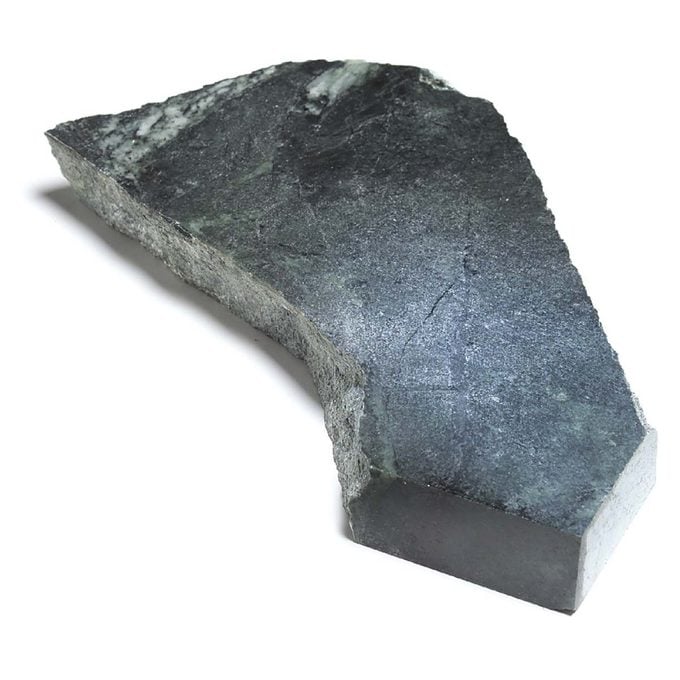
Soapstone
Soapstone has proven its durability through use in chemistry labs over the last 100 years. It has natural veining and a rugged natural look. One fabricator stated, “If you want a top that looks 100 years old the day you put it in, put in soapstone.” Although the material is relatively soft, an application of mineral oil will disguise most scratches. Heavier damage can be sanded out. Sinks can be seamlessly integrated into the top and it can be worked with carbide tools. Most sections are limited in length to 6 ft. Most granite fabricators can fabricate soapstone tops.
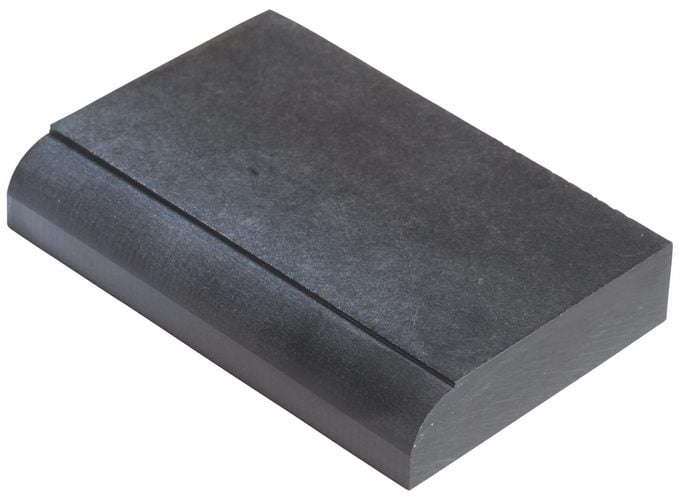
Richlite
Richlite is composed of more than 60 percent paper, but it looks and acts more like stone or wood. Used in commercial kitchens and food-processing plants for decades, the phenolic wood material (according to the manufacturer) resists heat, stains and scratches and “lasts a lifetime.” It can be installed by do-it-yourselfers and has a warm, soft look and feel. Costs start at about $25 per square foot for the material.
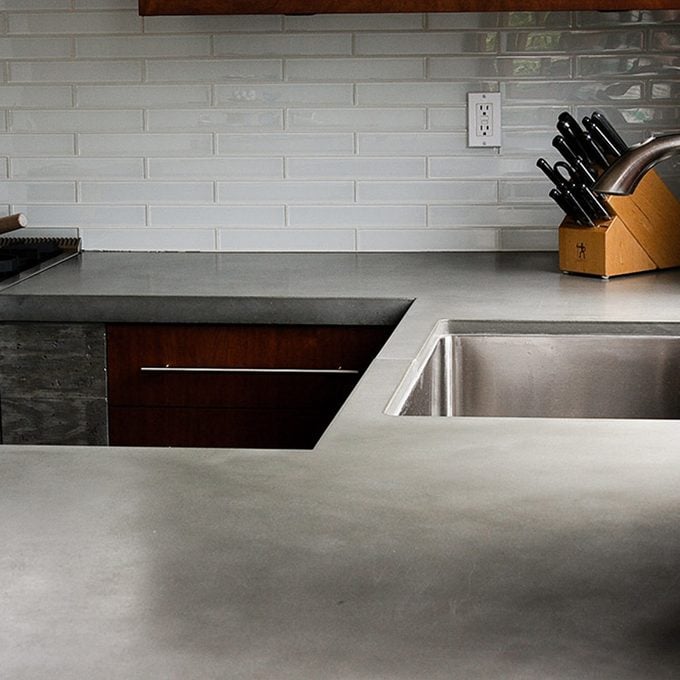
Concrete
Concrete countertops are expensive, easily stained (even with a lacquer finish), can chip easily, and are as hard as, well, concrete. So why would anyone install one? “They’re fun!” explained one fabricator. You can form them into any shape, embed stuff in them, dye them. And they’re durable and heat resistant. But only those committed to a fair level of maintenance should consider them.
Counter Costs
A chart comparing the cost of different countertop materials is available in Additional Information below.